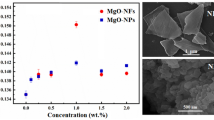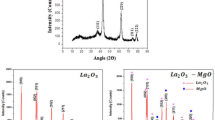Abstract
Soft chemical method was used to prepare ZnO nanoparticle at different mole concentrations, and the particles was dispersed in oil (groundnut oil and mustard oil). Dielectric behavior of the nanofluid was premeditated at different temperatures. The composition of ZnO was studied using energy-dispersive X-ray spectroscopy, and structural analysis of ZnO ceramic was studied with X-ray diffractograms technique that investigates the prepared powders are crystalline in nature with an average grain size of 29 nm. Surface morphological analysis was investigated using scanning electron microscope. To investigate the dielectric constants (DC) of ZnO nanofluid, a capacitive method using impedance LCR (inductance capacitance and resistance) meter was experiential between the temperatures 45–85 °C. It was observed that DC of nanofluid decreases with rise in temperature and attain saturation at high temperature due to the stability of ZnO. The experiential data and its deviation of linearity were studied using Arrhenius and Andrade’s equation taking ln (ε′) with temperature (R2 > 0.915). tert-butylhydroquinone (TBHQ-antioxidant) was added with the base fluid and nanofluid to compare the increasing stability of ZnO nanofluid. The perpetual dielectric nature of ZnO nanofluid at high temperature can be used in industries as a coolant and lubricant.







Similar content being viewed by others
References
Agrawal S, Deepak B (2005) Dielectric study of binary mixtures of edible unsaturated oils. Ind J Pure Appl Phys 43:624–629
Bartnikas R (2001) Engineering dielectrics volume III electrical insulating liquids. ASTM-31002093-21
Duangtongsuk W, Wongwises S (2009) Measurement of temperature dependent thermal conductivity and viscosity of TiO2-water nanofluids. Exp Therm Fluid Sci 33:706–714
Kumar D, Singh A, Tarsikka PS (2013) Interrelationship between viscosity and electrical properties for edible oils. J Food Sci Technol 50:549–554
Lee JC, Seo HS, Kim YJ (2012) The increased dielectric breakdown voltage of transformer oil-based nanofluids by an external magnetic field. Int J Therm Sci 62:29–33
Li D, Haneda H (2003) Morphologies of zinc oxide particles and their effects on photocatalysis. Chemosphere 51:129–137
Li D, Haneda H, Kawano K, Saito N (2001) Synthesis and photocatalysis of monodispersed zinc oxide powders with different morphologies. J Jpn Soc Powder Powder Metall 48:1044–1050. https://doi.org/10.2497/jjspm.48.1044
Lizhi H, Toyoda K, Ihara I (2008) Dielectric properties of edible oils and fatty acids as a function of frequency, temperature, moisture and composition. J Food Eng 88:151–158
Mahbubul IM, Saidur R, Amalina MA (2012) Latest developments on the viscosity of nanofluids. Int J Heat Mass Transf 55:874–885
McShane CP (2001) Relative properties of the new combustion-resist vegetable-oil-based dielectric coolants for distribution and power transformers. IEEE Trans Ind Appl 37:1132–1139. https://doi.org/10.1109/28.936406
Nabeel Rashin M, Hemalatha J (2013) Viscosity studies on novel copper oxide-coconut oil nanofluid. Exp Therm Fluid Sci 48:67–72. https://doi.org/10.1016/j.expthermflusci.2013.02.009
Ranjith KS, Kumar RTR, Garg AB, Mittal R, Mukhopadhyay R (2011) Morphology dependent photocatalytic properties of ZnO nanostructures. In: AIP conference proceedings, pp 431–432. https://doi.org/10.1063/1.3605919
Rezapour M, Talebian N (2011) Comparison of structural, optical properties and photocatalytic activity of ZnO with different morphologies: effect of synthesis methods and reaction media. Mater Chem Phys 29:249–255
Rubalya Valantina S, Susan D, Bavasri S, Priyadarshini V, Ramya R, Saraswathi Suriya M (2015) Experimental investigation of electro-rheological properties of modeled vegetable oils. J Food Sci Technol 53:1328–1337
Rubalya Valantina S, Phebee Angeline DR, Uma S, Jeya Prakash BG (2017) Estimation of dielectric constant of oil solution in the quality analysis of heated vegetable oil. J Mol Liq 238:136–144. https://doi.org/10.1016/j.molliq.2017.04.107
Rubalya Valantina S, Arockia Jayalatha K, Phebee Angeline DR, Uma S, Ashvanth B (2018) Synthesis and characterisation of electro-rheological property of novel eco-friendly rice bran oil and nanofluid. J Mol Liq 256:256–266. https://doi.org/10.1016/j.molliq.2018.01.183
Rudan-Tasič D, Klofutar C (1999) Characteristics of vegetable oils of some Slovene manufacturers. Acta Chim Slov 46:511–521
Tuncer E, Serdyuk YV, Gubanski SM (2002) Dielectric mixtures: electrical properties and modeling. IEEE Trans Dielectr Electr Insul 9:809–828. https://doi.org/10.1109/TDEI.2002.1038664
Wang B, Wang X, Lou W, Hao J (2010) Rheological and tribological properties of ionic liquid-based nanofluids containing functionalized multi-walled carbon nanotubes. J Phys Chem C 114:8749–8754. https://doi.org/10.1021/jp1005346
Wei XQ, Man BY, Liu M, Xue CS, Zhuang HZ, Yang C (2007) Blue luminescent centers and microstructural evaluation by XPS and Raman in ZnO thin films annealed in vacuum, N2 and O2. Phys B 388:145
Xie J, Li Y, Zhao W, Bian L, Wei Y (2011) Simple fabrication and photocatalytic activity of ZnO particles with different morphologies. Powder Technol 207:140–144
Yu H, Xu Y, Shi P, Xu B, Wang X, Liu Q (2008) Tribological properties and lubricating mechanisms of Cu nano particles in lubricant. Trans Nonferr Metals Soc China 18:636–641
Yves BERTRAND (2012) Development of a low viscosity insulating fluid based on vegetable oil. In: International symposium on electrical insulation, CIRED, Stockholm
Zakaria I, Azmi WH, Mohamed WANW, Mamat R, Najafi G (2015) Experimental investigation of thermal conductivity and electrical conductivity of Al2O3 nanofluid in water—ethylene glycol mixture for proton exchange membrane fuel cell application. Int Commun Heat Mass Transf 61:61–68. https://doi.org/10.1016/j.icheatmasstransfer.2014.12.015
Acknowledgements
Authors gratefully acknowledge Vice Chancellor of SASTRA Deemed University, for the support to carry out the research work in the University Laboratory.
Funding
This research did not receive any specific grant from funding agencies in the public, commercial or not-for-profit sectors.
Author information
Authors and Affiliations
Corresponding author
Ethics declarations
Conflict of interest
The authors declare that they have no conflict of interest.
Rights and permissions
About this article
Cite this article
Subramanian, S., Devadasan Racheal, P.A., Sathianathan, R.V. et al. Structural and Dielectric Properties of Groundnut Oil, Mustard Oil and ZnO Nanofluid. Iran J Sci Technol Trans Sci 43, 1351–1359 (2019). https://doi.org/10.1007/s40995-018-0631-8
Received:
Accepted:
Published:
Issue Date:
DOI: https://doi.org/10.1007/s40995-018-0631-8




